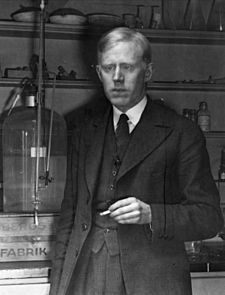Odd Hassel facts for kids
Quick facts for kids
Odd Hassel
|
|
|---|---|

Odd Hassel, c.1935
|
|
| Born | 17 May 1897 Kristiania, Norway
|
| Died | 11 May 1981 (aged 83) Oslo, Norway
|
| Nationality | Norwegian |
| Alma mater | University of Oslo |
| Awards | Nobel Prize in Chemistry (1969) |
| Scientific career | |
| Fields | Physical chemistry |
| Institutions | University of Oslo University of Berlin |
Odd Hassel (born May 17, 1897 – died May 11, 1981) was a brilliant Norwegian scientist. He was a physical chemist who won the Nobel Prize in Chemistry.
Biography
Odd Hassel was born in Kristiania, Norway, which is now known as Oslo. His father, Ernst Hassel, was a doctor. In 1915, Odd began studying at the University of Oslo. He focused on mathematics, physics, and chemistry. He finished his studies in 1920.
After a year off, he traveled to Munich, Germany. There, he worked in a laboratory with Professor Kasimir Fajans. His work helped discover how certain chemicals absorb light. Later, he moved to Berlin and started researching using X-ray crystallography. This method uses X-rays to figure out the exact arrangement of atoms in crystals.
He continued his research with help from a special grant called a Rockefeller Fellowship. In 1924, he earned his PhD from Humboldt University of Berlin. After that, he returned to his old university, the University of Oslo. He worked there from 1925 until 1964, becoming a professor in 1934.
His work was stopped for a while in October 1943. During World War II, he and other university staff were arrested. He was held in different camps until he was set free in November 1944.
Discoveries in Chemistry
Odd Hassel first studied inorganic chemistry, which is about chemicals that don't usually contain carbon. But around 1930, he started focusing on how molecules are shaped. He was especially interested in the structure of a molecule called cyclohexane and similar compounds.
He taught Norwegian scientists about new ideas. These included electric dipole moments, which describe how electric charges are spread out in a molecule. He also introduced electron diffraction, a way to study molecular structures using electrons.
Hassel is most famous for showing that molecules have a three-dimensional shape. Before his work, many scientists thought that ring-shaped carbon molecules were flat. But Hassel believed they filled three dimensions, not just two.
He used the number of bonds between carbon and hydrogen atoms to prove his idea. He showed that it was impossible for these molecules to exist on only one flat surface. This important discovery changed how scientists understood molecular shapes. It led to him winning the Nobel Prize in Chemistry in 1969.
Awards and Honors
Odd Hassel received the Nobel Prize in Chemistry in 1969. He shared this award with an English chemist named Derek Barton.
He also received several other important awards in Norway. These included the Guldberg-Waage Medal and the Gunnerus Medal, both in 1964.
Many universities honored him too. He received special honorary degrees from the University of Copenhagen in 1950 and the University of Stockholm in 1960. Today, an annual lecture is given in his honor at the University of Oslo.
He was also an honorary member of many important scientific groups. These included the Norwegian Chemical Society and the Chemical Society of London. In 1960, he was made a Knight of the Order of St. Olav, a high honor in Norway.
See also
 In Spanish: Odd Hassel para niños
In Spanish: Odd Hassel para niños
- Cyclohexane conformation
- Halogen bond
Images for kids
-
Heinrich Jacob Goldschmidt was Hassel's thesis advisor and father of Victor Goldschmidt.


